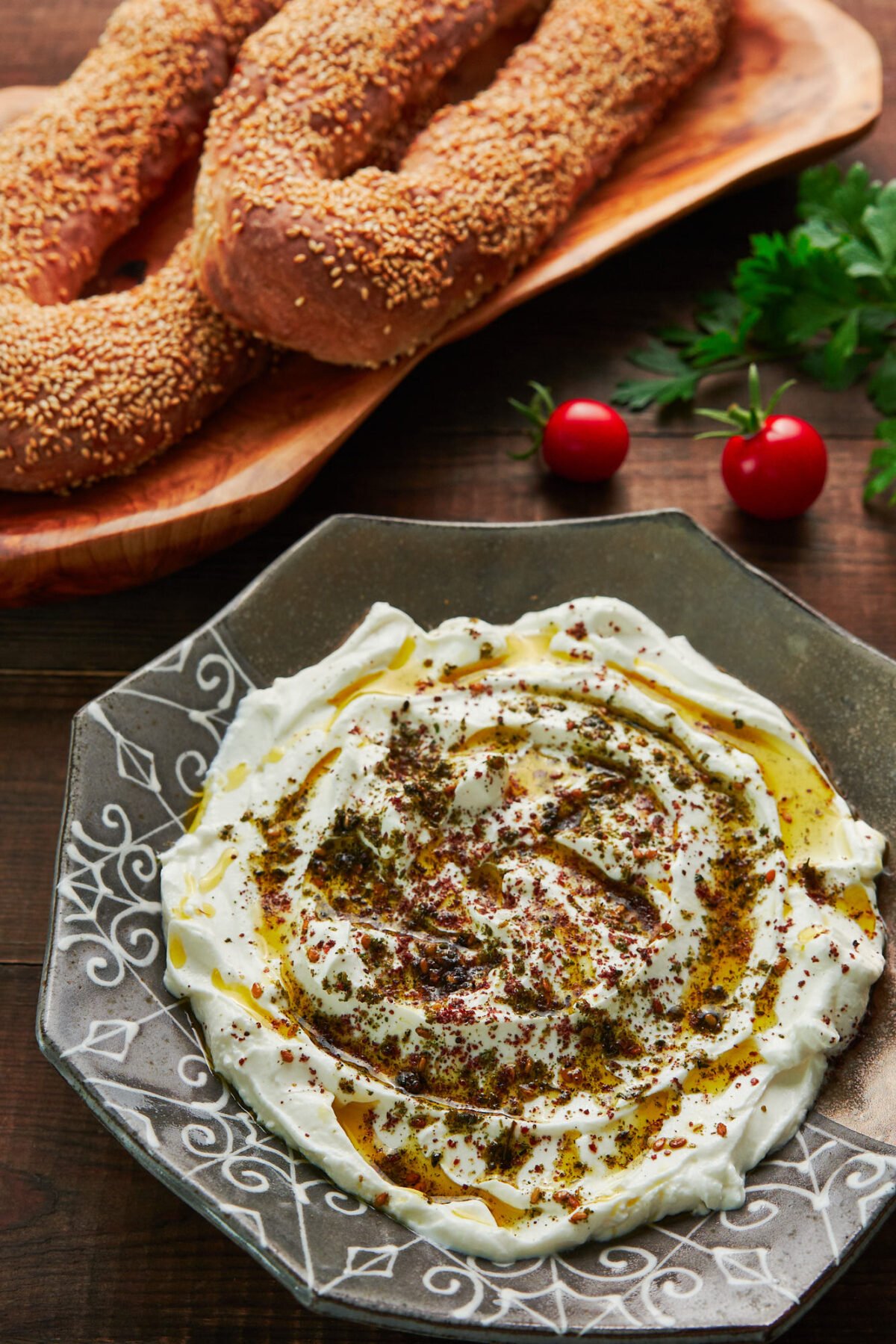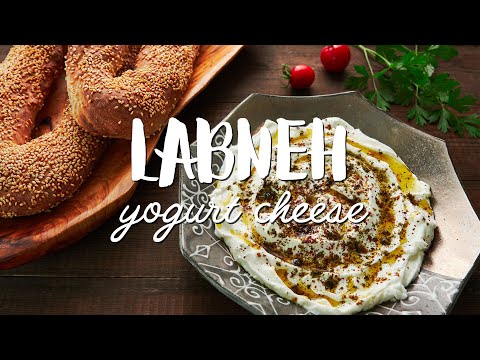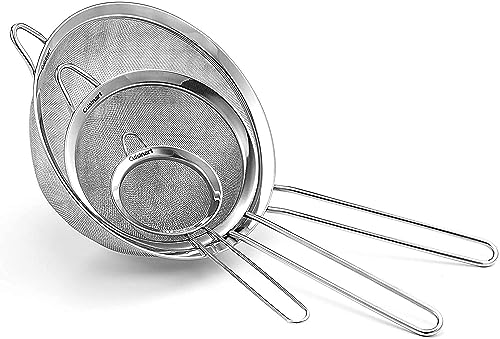
Labneh dip (sometimes spelled labaneh or labna) is the Middle Eastern answer to cream cheese. By draining off the whey, this strained yogurt cheese reaches its fullest flavor, making it a versatile condiment and spread. I first discovered it in Saudi Arabia, where it's drizzled with olive oil, sprinkled with zaatar, and scooped up with tender swaths of pita bread. Similar to Greek yogurt, the straining process concentrates its protein and probiotics. However, by straining it for even longer, it evolves into a thick, tangy spread that's just as good with breakfast bagels as it's on a mezze platter. Once you try this labneh recipe, it's hard to go back to the stuff from Whole Foods and Trader Joe's.
Jump to:
Why This Recipe Works
- Strained yogurt = creamier texture. Removing whey concentrates both the flavor and protein, giving labneh its signature body and tang.
- Salt-driven whey extraction: Stirring in salt draws moisture out of yogurt via osmosis, concentrating proteins and fats for a rich, cheese-like consistency.
- Time does the heavy lifting. No cooking required. Just gravity and patience.
- Flavor scaffolding: A drizzle of good olive oil plus zaatar and sumac introduces bright, herbal, and smoky notes that complement the tang of the strained yogurt.
Ingredients
- Yogurt — Full-fat plain yogurt gives you the creamiest, richest labneh. If you're in a rush, you can start with Greek yogurt to reduce the straining time.
- Salt — Salt not only seasons but also draws out the whey, thickening the yogurt naturally while highlighting its umami and giving it a cheesy flavor.
- Olive oil (garnish) — A fruity olive oil adds richness and a marvelous green flavor to the Labneh dip.
- Zaatar (garnish) — This blend of herbs and spices varies by region but often includes thyme, oregano, marjoram, sumac, and sesame seeds. It contributes bright herbal notes contrasted by the nutty sesame.
- Sumac (garnish) — While zaatar often includes some sumac, I love doubling down on this lemony spice, which brings a pop of color and citrusy lift to each bite.
Labneh Pronunciation
Labneh (/læbˈneɪ/) is pronounced as two clear syllables LAB-nay with the emphasis on the second part. The first syllable, “lab,” sounds just like the English word for a science lab, and the second, “neh,” rhymes with “day” or “say.”
How to Make Labneh
First, whisk the salt into your yogurt until it's completely dissolved. This jump-starts the whey separation process. Then, line a sieve with a damp piece of butter muslin, a coffee filter, or a wet paper towel, and set it over a bowl to catch the liquid.
Pour the salted yogurt into the lined sieve then cover and refrigerate overnight. The yogurt will release the most whey during the first 2-3 hours, so check it at this point and drain off the whey once. Then, continue letting it strain until your yogurt cream cheese reaches your desired thickness.
To serve the labneh dip, transfer it to a serving dish and use a spoon to flatten and create swirls on top to hold your garnishes. Finish by drizzling with olive oil and sprinkling zaatar and sumac on top. Store any leftovers in an airtight container for up to a few days.

Serve This With
Pair this homemade labneh dip with pita and a vibrant lineup of mezze, like smoky Mutabbal—a rich, tahini-kissed eggplant spread. Brighten things up with fresh parsley and bulgur Tabouleh or a refreshing Watermelon Salad with mint and labneh. If you're craving something comforting, a dollop of zaatar labneh perfectly enriches a bowl of lentil Shorbat Adas. For a heartier option, platters of Ful Medames or tender, Olive Oil Braised Green Beans beautifully round out your Middle Eastern meal.
📖 Recipe


Equipment
Units
Ingredients
- 800 grams yogurt
- 1 teaspoon salt
- 2 tablespoons olive oil for garnish
- zaatar for garnish
- sumac for garnish
Instructions
- Whisk 1 teaspoon salt into 800 grams yogurt.

- Wet a clean piece of food-safe cotton fabric such as a butter muslin and wring out any excess water. You can also use a large coffee filter or even a wet paper towel. Line the inside of a wire sieve with the damp cloth or filter and set it over a bowl.

- Pour the yogurt into the lined sieve. Cover and refrigerate for 2-3 hours. You'll have a lot of whey accumulated in the bottom of the bowl which you can discard (or save and use to marinate meat or fish). Put the sieve back over the bowl and continue to drain the yogurt overnight.

- When the Labneh is done, it should be at least as thick as soft butter, but you can continue straining it longer if you want it to be firmer.

- Transfer the Labneh to a serving dish and use a spoon to flatten it out and make swirls in the top.

- Drizzle the labneh dip with 2 tablespoons olive oil. Garnish with zaatar and sumac.

Nutrition Facts
FAQs
Labneh, sometimes written Lebni, Labne, or Labna, is the transliteration of the Arabic word "لبنة". It's a fresh cheese made by salting and straining yogurt to varying degrees and is eaten much like you'd eat other soft cheeses.
Yogurt is made by inoculating milk with bacteria such as strains of lactobacillus and bifidobacteria which occur naturally on the surface of plants. Although it's said to have originated over 7000 years ago in Mesopotamia, the abundance of the bacteria that creates yogurt means it was most likely discovered by accident in many places where humans were harvesting and storing milk from animals.
Yogurt is a traditional food that spans Europe from the South to the East, and in Asia from the West to the South. Most of these regions have some form of strained yogurt, but Labneh is unique to the Middle East and is used widely in Levantine, Arabic, and Persian cuisines.
Although they're both strained yogurt, Labneh is usually salted and strained for an extended period, which makes it more like cheese than yogurt. It can even be dried to make a hard cheese.









Kathy Stroup says
Fabulous! I think I can even manage to make this during the heat wave. I always buy Greek yogurt so it won't take any time at all to drain.
Marc Matsumoto says
Greek yogurt will be almost all the way there, some brands might not even need to be strained. It's a great thing to have on hand when it's too hot as long as a you have a good bakery nearby where you can get good bread. But I guess you're trying to cut carbs, so it's good for salads too!